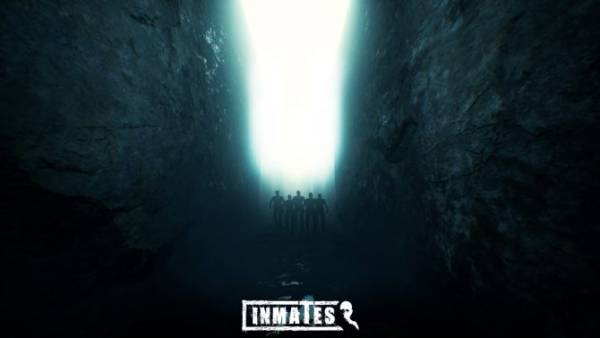StarDrive is a 4X, action strategy game for PC, developed by Zero Sum Games and published by Iceberg Interactive.
Before the review, a brief lesson in 4X gaming. For the uninitiated, 4X stands for eXplore, eXpand, eXploit and eXterminate (it should probably be called a 4E game, but sadly E isn’t as cool as X). The basic idea is to build an empire from nothing until you rule the Earth, the solar system or the whole damn galaxy. As genres go, it’s pretty niche, with the Civilization games standing out as the only mainstream titles in its arsenal. However if you’re willing to don your thick-rimmed glasses, squeeze into your skinny jeans and delve into the underground gaming scene then you will find a plethora of 4X titles waiting for you. Beware though, for 4X is not a genre to be entered into lightly. You may begin bright-eyed and full of wonder, but you could soon drown in a sea of micromanagement and poor design. Many games have tried to counter these problems, with varying degrees of success, but we are still missing our crowning jewel. So can StarDrive break the mould and provide an engaging and in-depth 4X experience, without crushing us under a mountain of red tape and census data?
Like almost every game in the genre, there is no campaign as such. Every game of a 4X should feel like a campaign in itself, so tacking one on and funnelling the player down a set path doesn’t sit well with the concept of ruling an intergalactic empire. When starting up a new game, the player is greeted with the usual repertoire of options for any space-based 4X title. You can choose the galaxy size, abundance of star systems, number of players, game speed and difficulty. These options are all fine, although a little more customisation would have been nice. For example you can choose how many opponents you want to play against, but you cannot choose which races they will be.
Speaking of races, StarDrive has 8 different playable races to choose from. While this isn’t a dizzying number, each race is well designed and has character. Our personal favourite here at VGU has to be the Kulrathi, a race of honour-driven samurai bears. There is also a trait system which allows you to purchase positive and negative traits for your race. Each pre-set race starts with its points spent, but you can customise this before you start the game. So you could choose to have a polluted home world, making your starting planet worse obviously, but giving you more points to spend on making your race better at producing starships or fighting in close-combat.
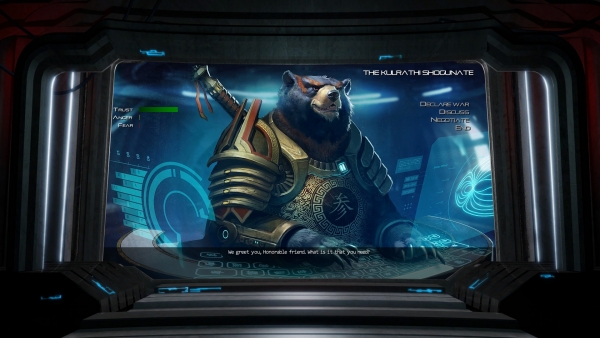 Ask him how he holds his sword without any thumbs, we dare you.
Ask him how he holds his sword without any thumbs, we dare you.
Much like Distant Worlds and Star Ruler, StarDrive isn’t turn-based as such. Everything happens in real time and an in-game ‘turn’ is five seconds of real time. You can speed up or slow down the in-game time speed, but how long a turn takes will always scale. So at 2x speed, a turn is every 2.5 real seconds and so on. This approach allows for much more interesting space combat, but it can allow you to become distracted and lose track of certain aspects of your empire. Thankfully the game can be paused at any time, allowing you to stop and take stock of the situation at hand. Once you get into the game you’ll be greeted by the view of your home planet as well as the few ships you start with. From there you can begin to explore the surrounding systems, colonise new planets and build your empire.
Unfortunately, the game doesn’t really tell you how to do any of this, at least not in-game. There are a couple of tutorial videos and a ton of text/image based tutorials available from the main menu or by clicking the help menu, but even these don’t really explain things very well. We can unashamedly say that we had to google how to land troops on an enemy planet. Some more video tutorials and a few in-game tool-tips would have been greatly appreciated. As a result, your first few attempts at StarDrive will probably just be trial runs whilst you get to grips with the gameplay mechanics. So StarDrive stumbles at the first hurdle, making the age old 4X blunder of having a learning curve as steep as Mt Everest. But is it worth the effort? Yes it is, and here’s why.
StarDrive is a massive game so the easiest way to break down this review is into those 4Xs we mentioned earlier, so how does StarDrive handle our first X, eXploration? The galaxy map is mercifully a pretty straightforward 2D representation with none of that trippy 3D nonsense they tried in Sword of the Stars. As you zoom in on a particular star system the various planets in orbit come into view, keeping the galaxy screen tidy until you need to concentrate on a specific system. You cannot see a system’s planets until you have sent a scout to that system, nor can you see a planet’s traits until you’ve had a ship in orbit. Planetary scans reveal how fertile the world is; which controls how good is at producing food, and how mineral rich it is; which determines how good at production it will be. Your ships can also detect anomalies on a planet’s surface from orbit, which you can then explore with ground troops to uncover its secrets. Scouting itself can be automated if you set a specific ship class as your scout class, then the game will automatically use all ships of that class to scout new systems.
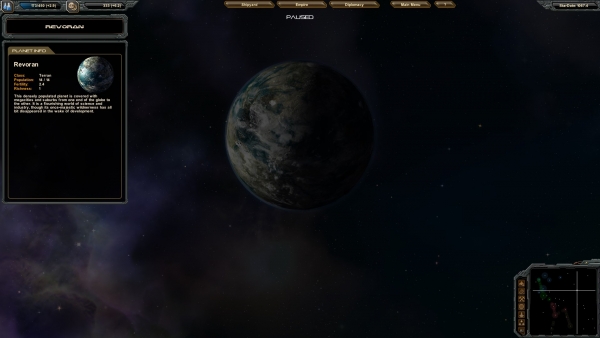 Not every planet you find will be uninhabited, so proceed with caution and remember the Prime Directive.
Not every planet you find will be uninhabited, so proceed with caution and remember the Prime Directive.
So onto the second of our evil X’s, Lucas Lee… no wait that’s not right, eXpand. Expansion is handled exceptionally well in StarDrive. You simply click on the planet you would like to colonise and click the aptly titled colonise button. One of your current colonies will then automatically build a colony ship and send it to your new world. This is a nice, simple system that helps reduce some of the micromanagement involved in building colony ships and sending them on their way. Just click colonise planet then come back once it’s yours. Players can also expand their territory by building subspace projectors which have an area of influence around them. Any ship of yours travelling within one of your subspace projectors range will receive a bonus to their faster-than-light (ftl) flight speed. Random events called ‘Hyperspace Fluxes’ can also temporarily shut down all ftl travel in the galaxy, messing with your plans and generally mixing things up.
Once you’ve grabbed yourself a tasty little colony in the far reaches of known space, it’s time to get building, which brings us nicely into our third X’s domain, eXploitation.
First things first, allow us to explain the economy system in StarDrive. There are 4 different resources for you to manage; food, production, research and credits. Credits are acquired based on your total empire population and your tax rate. Research points are acquired from all your colonies and poured into a collective pool which is spent on researching techs every turn. However, food and production are colony specific resources which must be managed. Food keeps the population alive and production is used to build things. The amount of food, production and research a planet kicks out can be adjusted using 3 slider bars in the Colony Management Screen. If a world is producing extra food or production, it can be set to export those spare resources to another world that isn’t doing too well. Provided you’ve been through the tutorials and found out how, this entire process can be automated with colonies producing transport ships and shipping goods all by themselves.
Research points are spent in the tech tree, which is split up into 6 categories; Colonisation, Energy, Socio-Logistics, Physics, Space Weapons and Starship Construction. There is also a 7th ‘secret’ category to do with ancient alien technology but you have to find some first. You pick your tech and wait until it’s been researched, it’s all very simple. There is no macro-improvement in the techs either, so no getting railguns, then moving up to railguns mark II and so on. Once you’ve got railguns that’s it, they are the railguns you’ll have until the very end of the game. This is nice to see as the constant retrofitting of ships and colonies that macro-improvement brings is avoided. The only real downside to the tech system is that there are no race-specific tech trees which is a shame. The mind controlling Codrazine could have some very different ideas about population control than the pack-like Vulfen and it would have been nice to see some variety here.
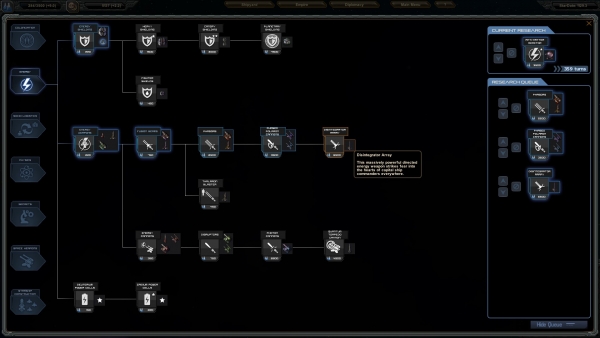
Disintegrator Array you say? We’ll take a dozen to go.
You can double-click on any of your colonies and you’ll be greeted by the Colony Management Screen. From here you can see all the available slots on your planet for building structures. The coloured squares can be built on, whilst the blacked out squares represent ‘uninhabitable land’ which must first have a biosphere built over it before it can be used. There are plenty of structures to build, though almost all of them have to be unlocked in the tech tree. Military bases and planetary shields can protect your colony from attack, whilst research labs, aeroponics farms and rover bays can improve your colonies output.
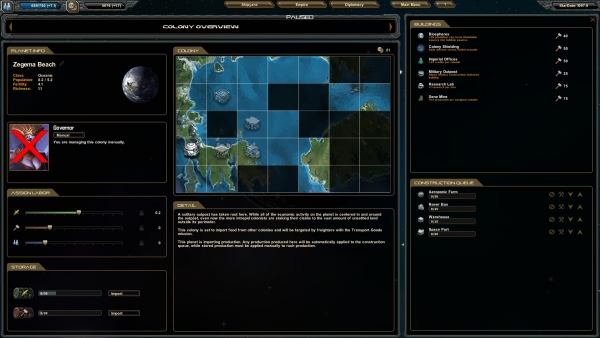 Zegema Beach, I’ve always wanted to go there…
Zegema Beach, I’ve always wanted to go there…
You can also set a planetary governor from here, who can manage the colony for you if you really want to cut out the micromanagement and just concentrate on the pew pew. Speaking of which, how does StarDrive handle the 4th and arguably most important X, eXtermination?
StarDrive’s entire approach to space combat is simply fantastic; from the designing of ships and the deploying of fleets to the epic battles themselves. The ship design system is the finest we’ve ever seen in a 4X game and really allows you to customise every aspect of your ship, from the guns, shields and armour down to the power supply and storage. Using this system you can create any ship to suit any situation. The main limitations to your ship are building space, mass, ammo and energy.
Mass is used to tandem with your engine power calculate how manoeuvrable your ship is, so if you load your ship up with heavy armour plating then don’t expect it to be too nippy in the turns (unless you found some kind of inertial damper technology hiding in the tech tree, but that’s just crazy talk). Shields are also available as alternatives to armour, but they use up a lot of power and only cover a certain area, so you’ll probably need more than one generator to completely protect your ship. Ammo is required for all conventional and missile weapons and is stored in cargo bays which take up valuable space on your ship. You can counter this by using energy weapons, but you will increase the strain on your ship’s power core. So if you’re like us and want to build a giant laser-wielding doom ship with enough shields to withstand a direct hit from the Death Star, then you’re going to need more than a few generators on your ship, as you can see below.
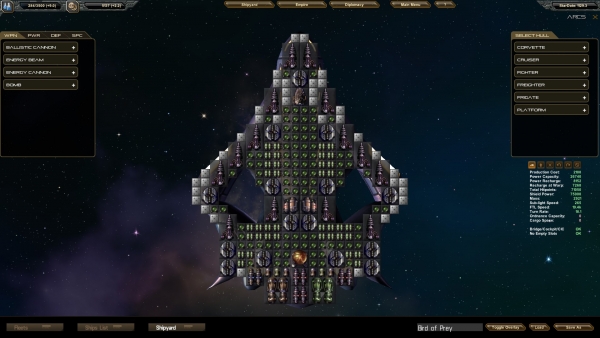 Those little green blobs you can see in the ship are power generators…we may have gone a bit overboard on them.
Those little green blobs you can see in the ship are power generators…we may have gone a bit overboard on them.
Once you’ve assembled your mighty warship, it’s time to go find someone else in the galaxy and make them not be there anymore. Of course it’s dangerous to go alone, so you should probably take a whole fleet with you. Fleets can be made either by grabbing a load of ships and grouping them together, or created in the Shipyard Menu. Be warned that using the former option cancels all current orders the ships have, so if you grab them, send them somewhere and then form the fleet they’ll all just sit around twiddling their thumbs. Using the latter option, you can alter the formation your ships will fly in, and even design fleets based off your current ship designs and the requisition that fleet to be built, whereupon your colonies will construct the ships and form them into a fleet automatically. This system is brilliant and really helps you to keep your war machine rolling with minimal micromanagement.
Ships and fleets are simple to control. By default they will move at the speed of the slowest ship, though you can command them to move at their full speed should the need arise. Once you find an enemy fleet to pacify, simply right click the enemy ships to attack. Ships have several automatic behaviours which you can select for them, such as to keep their distance, make strafing runs or broadside their targets. This allows for some very cool fleet tactics, with fighters performing close sweeps while your artillery ships sound off from the rear.
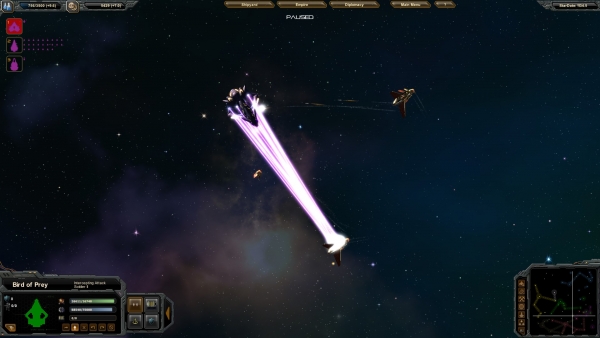 Imma firin mah lazer…well 14 lasers if you want to get technical.
Imma firin mah lazer…well 14 lasers if you want to get technical.
Once you’ve reduced the enemy fleet to space dust, it’s time to put boots on the ground. The ground combat system is very bare bones. You land dudes, they automatically attack the enemy dudes and structures. Keep fighting until you win or you run out of dudes. It’s basic but it doesn’t need to be any more complicated than this. Ground battles are small potatoes when you’re running an intergalactic empire.
We’re all about the substance here at VGU, but that doesn’t mean we don’t care about style. Graphically StarDrive isn’t going to set your GPU on fire, but it’s still a pretty game to look at. If you zoomed into the ships close enough to see through the windows then the textures would start to get ugly, but the game is impossible to play at that level anyway. 90% of the time you’ll be zoomed out so far you’ll barely be able to see the planets, never mind your ships. In combat the special effects all do their jobs and give you the sense that your giant laser cannon is really ruining someone’s day, and that feeling always gets a thumbs up from us.
On the sound front things are equally pleasing. The game is accompanied by a chilled out, futuristic soundtrack very reminiscent of FTL. The weapon sounds are pretty good too, although you have to be zoomed in to the max in order for them to be audible. It’s obvious this was done to prevent you hearing laser blasts when you’re trying to manage a colony nowhere near the fight, but it could use some fine tuning.
Overall StarDrive is not an easy game to get your head around and it will take you some time to get to grips with. But we implore you, stick with it, for the love of everything holy use the tutorials and you will be rewarded in the end. This is without a shadow-of-a-doubt the finest 4X space game in the alpha quadrant, and may even be the ultimate power in the genre.
